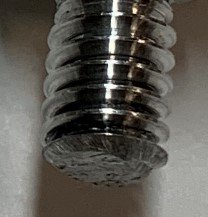Tried a piece of 12L14 with the handwheel setup. Boy, that handwheel really helped! Made it a lot easier. Was able to make some decent threads. They are better than the originals. They ought to be, since I'm using 12L14. (I bought some more of these pins - got to keep the economy going.) Looking carefully at the originals, it is obvious they were single point threaded. And there is no groove, the threads just start. (Original on top, 12L14 on bottom)
View attachment 320105
I then tried turning the original 12L14 threads (hex stock - from early in this thread) down and recut them under power. This is with the threading tool I ground. The threads are better quality than with the LMS threading bit, but there are some burrs. Looking carefully at my tool, I see the tip is cracked off. Now, I put in a flat on this tool along the edge. The flat can't be too wide, or I can't do 32 TPI threads.
View attachment 320106
I seem to be breaking off the tip. What could cause this?
I'd like to make a relief for the thread. What kind of tool is used for this? Could one grind a parting tool thinner? (Have a spare blade) The
relief that is there was just keeping the threading tool in the same place, but that doesn't create the square shoulder that it should have.



